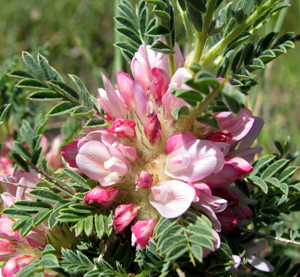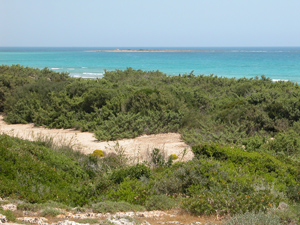Sicily - Island characteristics overview

Astragalus siculus from Mt. Etna (Photo: G.P. Giusso del Galdo)
.jpg)
Saponaria sicula from Mt. Etna (Photo: G.P. Giusso del Galdo)

Coastal vegetation with Juniperus macrocarpa from Vendicari (Photo: P. Minissale)
.jpg)
Pine dominated vegetation from Mt. Etna (Photo: G.P. Giusso del Galdo)
Sicily is the largest Mediterranean island, with an extension of approximately 26,000 km2. The Sicilian territory is predominantly hilly or mountainous. The geographical position of Sicily, its geological history, together with its high ecological diversity make the island an extremely heterogeneous territory, thus becoming one of the most impressive example of a Mediterranean natural mosaic.
The highest peak of the island, dominating the eastern sector of Sicily, is Mt. Etna (about 3,320m a.s.l.), which is also the biggest active volcano of the Mediterranean. Apart from Etna, the main elevations of Sicily (ranging from 1,400 to 1,979 m a.s.l.) are from east to west: Peloritani, Nebrodi and Madonie. The central and southern parts of Sicily are rather hilly, and geologically complex. The so-called “Hyblaean Plateau” is formed by Mesozoic carbonatic substrates and occupies most of the south-eastern sector of Sicily.
Following the bioclimatic classification of Rivas-Martínez (1996-2009), Sicily falls within the Mediterranean pluviseasonal oceanic bioclimate, with mean annual temperatures ranging between 17-18 °C at the sea level and 7-5 °C at around 1,800 m a.s.l. Temperatures are depending not only by the altitude, but even by the distance from the sea and by exposure as well. Precipitations are also extremely variable, being comprised between 400 mm/yr in the driest stands of southern Sicily and more than 1,500 mm/yr in the wettest north-facing slopes of the Sicilian high-mountain stands.
As concerns the floristic richness of Sicily, the vascular flora is currently estimated in more than 3,000 taxa (Giardina et al., 2007, Raimondo & Spadaro 2009), thus making the Sicilian territory as one of the richest in the Mediterranean Basin. The high diversity of Sicilian species is primarily related to its high topographic and bioclimatic diversity, but also to its geographical position, being Sicily a crossroad of the Mediterranean flora, where many plants are at the fringe of their distribution range. Land-bridge connections and subsequent repeated geographical isolations promoted both the survival of many relic species and the differentiation of a rich endemic flora, currently estimated in about 320 species.
The present-day vegetation of Sicily is chiefly represented by strongly modified or degraded plant communities, mostly resulting from the long-lasting exploitation of the island. The best and well preserved examples of natural vegetation are circumscribed to the most inaccessible stands, such as cliffs, steep slopes, windy ridges, and mountain tops. Apart from the chasmophytic vegetation and the orophilous plant communities, woods are poorly represented, at least in term of covered surface, and what is worse are badly preserved. Whereas, nowadays secondary phytocoenoses, synanthropic vegetation and cultivated fields are the most remarkable features of the Sicilian landscape.





